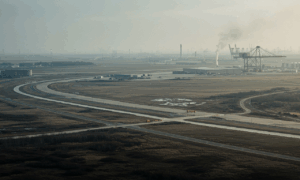The whispers of stagflation are growing louder, a concern for everyone, especially if you are managing household finances or perhaps planning significant projects like a home renovation where economic stability is key. Understanding what the Federal Reserve’s latest signals mean for your money is crucial in these uncertain times. This article will dissect the potential return of this challenging economic condition, explore what the Fed’s latest signals suggest, and offer practical insights to help you navigate its impact on your savings, investments, and even those major construction or upgrade plans you might be considering.
What Exactly is Stagflation? A Refresher
Stagflation is a particularly troublesome economic scenario characterized by a toxic trio of economic woes: stagnant economic growth (meaning the economy isn’t expanding or is growing very slowly), persistently high inflation (a rapid increase in the general price level, eroding your purchasing power), and relatively high unemployment. Unlike a typical recession where inflation often cools down, stagflation sees prices soar even as economic activity dwindles and joblessness rises.
This combination makes it incredibly difficult for policymakers, like the Federal Reserve (the Fed), to address. Traditional tools to combat inflation, such as raising interest rates, can further dampen economic growth. Conversely, measures to stimulate growth might exacerbate inflation. Many recall the 1970s as a prominent period of stagflation in several major economies, serving as a stark reminder of its disruptive potential.
The Fed’s Radar: Interpreting the Latest Signals
The Federal Reserve plays a pivotal role in managing the U.S. economy, primarily through its monetary policy. Its statements, interest rate decisions, and economic projections are scrutinized globally for clues about the economic trajectory. Recently, the Fed has been aggressively fighting inflation by raising interest rates. However, there’s an ongoing debate about whether these actions, while necessary to cool prices, could inadvertently push the economy towards stagnation or if they are enough to prevent stagflation.
Key signals from the Fed to watch include:
- Interest Rate Trajectory: Are they signaling more hikes, a pause, or potential cuts? Continued aggressive hikes could slow the economy more.
- Inflation Commentary: Does the Fed believe inflation is truly under control and heading towards its target (typically around 2%), or do they see persistent underlying pressures?
- Economic Growth Forecasts: What are their projections for Gross Domestic Product (GDP) growth? Downward revisions could signal concerns about stagnation.
- Labor Market Assessment: While a strong labor market is good, the Fed also watches for wage growth that might fuel inflation, or signs of weakening that could point to stagnation.
Understanding these nuanced signals helps in assessing whether the risk of stagflation is increasing or receding. The Fed aims for a soft landing – curbing inflation without causing a recession – but the path is narrow.

Inflation’s Grip: Is it Easing or Enduring?
High inflation has been a dominant global theme recently, impacting everything from your grocery bill to the cost of construction materials. While there have been periods where inflation showed signs of cooling, the persistence of certain price pressures remains a concern. Factors like ongoing supply chain disruptions, geopolitical instability affecting energy and food prices, and strong consumer demand in some sectors have all contributed.
The critical question is whether inflation will return to more normal levels and stay there, or if it will remain stubbornly high. Enduring high inflation, especially if coupled with slowing economic activity, is a core ingredient of stagflation. Keep an eye on the Consumer Price Index (CPI) and Producer Price Index (PPI) reports for insights into inflationary trends. These indices track the average change over time in the prices paid by urban consumers and domestic producers, respectively.
Economic Growth: Signs of a Slowdown?
The stagnation part of stagflation refers to weak or nonexistent economic growth. Indicators to monitor include GDP growth rates, manufacturing activity (like the ISM Manufacturing Index), consumer spending, and business investment. If these metrics consistently show weakness or decline while inflation remains high, it’s a significant red flag.
A slowing economy can also manifest in a cooling labor market, with slower job creation or rising unemployment claims. While central banks are trying to curb demand to fight inflation, they are walking a tightrope to avoid derailing economic growth entirely. The challenge is that some of the forces slowing growth might be beyond the Fed’s direct control, such as global economic headwinds or shifts in productivity.
How Stagflation Could Impact Your Finances and Projects
Stagflation presents a uniquely challenging environment for personal finances and larger financial undertakings, such as construction or renovation projects. Its dual nature of rising prices and a sluggish economy can squeeze households and businesses from multiple directions.
Consider these potential impacts:
- Erosion of Savings: Persistent high inflation means the cash you have in savings accounts loses purchasing power over time. What buys you a full shopping cart today might only buy three-quarters of a cart in a year.
- Investment Volatility: Financial markets often react negatively to stagflation. Some assets, like growth stocks, may underperform. The uncertainty can lead to increased market volatility, making investment decisions more complex.
- Higher Borrowing Costs: Efforts to combat inflation typically involve higher interest rates. This makes mortgages, car loans, personal loans, and credit card debt more expensive. For construction projects, this means financing becomes costlier and potentially harder to secure.
- Job Security Concerns: A stagnant economy can lead to hiring freezes, layoffs, and slower wage growth, impacting your income and overall financial stability.
- Impact on Construction and Renovation Projects:
- Material Costs: Inflation can drive up the prices of lumber, steel, cement, and other essential building materials, significantly increasing project budgets.
- Labor Shortages and Costs: A stagnant economy might not immediately ease labor shortages in skilled trades, and wage demands could remain high to keep pace with inflation.
- Project Viability: For larger projects, the combination of higher costs and economic uncertainty might lead some to postpone or scale back their plans. You might need to re-evaluate project scopes and timelines.
Strategies to Navigate a Potential Stagflationary Environment
While the prospect of stagflation can be daunting, proactive financial planning can help you build resilience. Here are some strategies to consider for your money:
Protect Your Savings and Manage Cash Flow
- Bolster Your Emergency Fund: In uncertain times, a robust emergency fund covering 6-12 months of essential living expenses is more critical than ever. This provides a buffer against job loss or unexpected costs.
- Combat Inflation: Explore savings vehicles that offer some protection against inflation, such as Treasury Inflation-Protected Securities (TIPS) or Series I Savings Bonds, if appropriate for your situation. Compare rates on high-yield savings accounts. More information on managing your savings effectively can be found on our site.
- Scrutinize Your Budget: Identify areas where you can cut back on non-essential spending to free up cash flow. Prioritize needs over wants.
Adjust Your Investment Strategy
- Diversify Wisely: Diversification across different asset classes (stocks, bonds, real estate, commodities) remains a cornerstone of sound investing. Stagflation can affect asset classes differently.
- Consider Real Assets: Historically, real assets like real estate and commodities (such as gold or oil) have sometimes performed better during inflationary periods. However, these also carry their own risks.
- Focus on Value and Quality: Companies with strong balance sheets, consistent cash flow, and pricing power (the ability to pass on cost increases to customers) may be better positioned.
- Avoid Panic Decisions: Emotional investing is rarely successful. Stick to your long-term investment plan and avoid making rash decisions based on short-term market noise.
Manage Debt Effectively
- Tackle High-Interest Debt: Prioritize paying down expensive variable-rate debt, like credit card balances, as interest rates may continue to rise.
- Refinance if Sensible: If you have existing fixed-rate debt at low rates, maintain it. If considering new loans, carefully weigh the costs and try to lock in fixed rates if possible, especially for large commitments like mortgages or project financing.
Enhance Your Income and Career Security
- Invest in Yourself: Upskilling or reskilling can make you more valuable in the job market and provide more career stability or opportunities for higher income.
- Explore Side Hustles: If feasible, consider additional income streams to supplement your primary earnings.
For Construction or Renovation Projects
- Rigorous Budgeting: Build significant contingencies (15-25% or more) into your project budget to account for unexpected cost escalations in materials or labor.
- Secure Fixed-Rate Financing Early: If you need to borrow for your project, try to lock in a fixed interest rate as soon as you are confident in your plans.
- Phase Your Project: If a large project seems too risky or expensive in the current climate, consider breaking it down into smaller, more manageable phases.
- Thoroughly Vet Professionals: If you are undertaking a significant renovation, ensure you work with contractors who have demonstrable experience and a solid track record of managing projects through various economic conditions. Request detailed proposals that clearly outline costs and timelines.
The Bigger Picture: Global Factors and Uncertainty
It’s important to remember that the U.S. economy does not operate in a vacuum. Global supply chains, geopolitical events, international energy markets, and the economic health of other major countries all play a role in shaping inflationary pressures and growth prospects. These external factors add layers of complexity and uncertainty to the economic outlook, making it harder to predict whether stagflation will fully materialize or how long it might last.
Navigating this uncertainty requires staying informed, being adaptable, and focusing on what you can control – your personal financial habits and strategic decisions. Keep abreast of economic news and analyses to better understand the evolving landscape.
Conclusions
The question of whether stagflation is back is complex, with valid arguments on both sides. The Fed’s signals indicate a continued fight against inflation, but the risk of an economic slowdown remains. For individuals, especially those planning significant financial commitments like construction or renovation projects, this environment calls for heightened vigilance and proactive financial management.
By understanding the potential impacts of stagflation on your money – from savings and investments to borrowing costs and project expenses – you can take informed steps. Strengthen your financial defenses, review your investment portfolio, manage debt prudently, and plan any major projects with extra care and contingency. While economic uncertainty can be unsettling, knowledge and preparation are your best allies in protecting your financial well-being.
Frequently Asked Questions (FAQ)
- What are the classic signs of stagflation I should watch for in the economy?
- Look for a combination of:
- Persistently high inflation rates (e.g., CPI remaining well above the Fed’s target).
- Low or negative GDP growth (economic output shrinking or barely growing).
- Rising or stubbornly high unemployment rates.
If all three conditions are present and sustained, it’s a strong indicator of stagflation.
- How is stagflation different from a regular recession?
- In a typical recession, economic activity slows down, and unemployment often rises, but inflation usually decreases due to lower demand. In stagflation, the economy slows down (stagnation) and unemployment may rise, but inflation remains stubbornly high. This combination of high inflation and low growth is what makes stagflation particularly challenging to manage.
- Should I halt my renovation plans if stagflation hits?
- Not necessarily, but you should proceed with extreme caution. Evaluate your financial stability, the necessity of the renovation, and your ability to absorb potential cost overruns. If the project is essential and you have secured fixed-rate financing and a robust contingency fund, it might still be feasible. However, if your finances are tight or the project is discretionary, postponing it until there’s more economic clarity could be a prudent decision. Consider phasing the project to manage costs and risks more effectively. If you do proceed, working with an experienced professional who can help navigate material sourcing and budget management is crucial.



